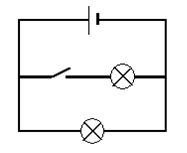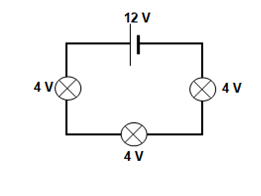Current
Current is a flow of electrons. The larger the current, the more electrons are flowing. To operate an electrical appliance, we must have current flowing through it.
Current is measured in Amperes or Amps (A).
Voltage
Voltage is a measure of the energy or “push” that individual charges have. “High Voltage” tells us that the individual charges have a lot of energy. Voltage is measured in Volts (V).
NB: Do not confuse voltage with current. It is possible to have a very high voltage (very energetic charges), but very low current (not many charges flowing).
Measuring Current and Voltage
Current is measured with a device called an ammeter. Voltage is measured using a voltmeter. These meters have to be connected in a particular way:
Circuits
An electrical circuit is a path or route around which current can flow.
Types of Circuits
Series Circuit
In a series circuit, the components are connected one after another in a single loop. There is only one path round the series circuit, and the current must go through each component in turn. There are no other routes for the charges to take.
If there is any break in the circuit, or if a component stops working, no current will be able to flow in the circuit, and all the components will stop working. e.g. Christmas tree lights!
Parallel circuit
A parallel circuit has different routes (or branches) available for the current as it travels around the circuit.
 Since the current can take different routes round the circuit, it is possible for some components to operate even if another is switched off or not working.
Since the current can take different routes round the circuit, it is possible for some components to operate even if another is switched off or not working.
In the diagram opposite, the top bulb is switched off, but the bottom bulb will still light.
Current in series and parallel
 Since the charges have no other path to take,
Since the charges have no other path to take,
the current is the same at all points in a series circuit
In the circuit below, the current will split as it reaches the parallel branches and will rejoin again after the branches.
The diagram shown below has 3 branches in the circuit so the current splits 3 ways.
Voltage in series and parallel
In the series circuit the supply voltage (energy) is shared between the components in the circuit.
The total voltage across the components in a series circuit is equal to the supply voltage.
In the series circuit the supply voltage (energy) is shared between the components in the circuit.
The total voltage across the components in a series circuit is equal to the supply voltage.
 In the parallel circuit, the voltage across each branch of the circuit is equal to the supply voltage.
In the parallel circuit, the voltage across each branch of the circuit is equal to the supply voltage.
This is because the voltage is a measure of the “push” that individual charges have been given by the supply. By choosing the top path, the charges have only one component on which to use up their energy. They will use all 5V on the top bulb.
Those charges choosing the bottom will be able to use all 5V on the bottom bulb.




